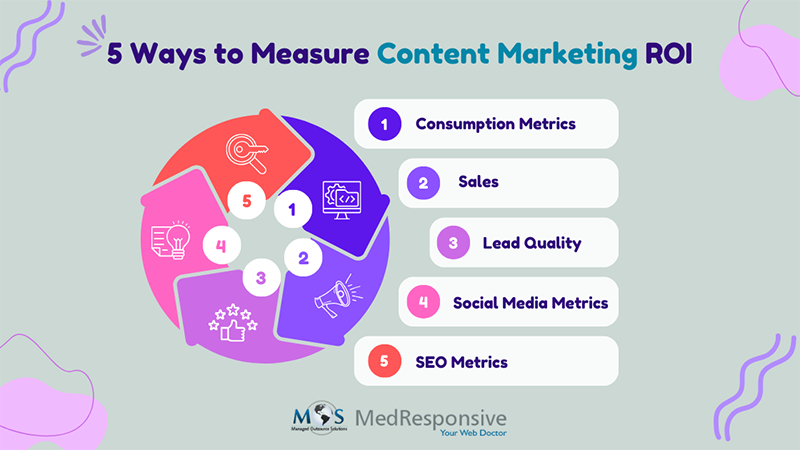A high return on investment is crucial for any marketing effort. If not, you can be losing your money and time. It’s important to make sure that the time you invest in creating content for content marketing is paying off. Content marketing is a constant process, much like all your marketing endeavors. You hope that an article or video case study will perform even better than it did the last time it is published or uploaded. The most effective method to do this is to track your progress as your campaigns develop and grow. A reliable provider of organic SEO services helps businesses monitor the ROI of their content marketing.
What Do You Mean by Content Marketing ROI?
Content marketing ROI is the difference between what you make and what you spend on content marketing. This figure represents the percentage of money you get paid for your material. Almost anything you put online can be considered content.
The different types of content include:
- Blogs
- Articles
- Emails
- Infographics
- Content for social media
- Videos
- Presentations and slide shows
Importance of Calculating ROI of Content Marketing
- Enhances your website’s search engine optimization (SEO): It helps search engines find your website and move it up the ranks on the search engine results pages. You can determine which pages are effective for SEO by knowing your return on investment from content marketing.
- Persuades decision-makers: Demonstrating to those outside the business how marketing benefits organizations can be difficult, regardless of whether you employ an agency or have an internal marketing team. ROI provides information to support increased investment in growth-oriented tactics.
- Allocate spending: As a business, your objective is to make investments in strategies that increase sales for your enterprise. You need statistics to back up your investments if you want to make an impact.
Measuring Content Marketing ROI
- Consumption metrics: What was the viewership of your content marketing campaigns? You should start by asking yourself that question for everything you create and publish. Websites like Google Analytics, which automatically collect data and generate reports based on predetermined criteria, can help you locate the answer.
- Unique visits
- The percentage of users who abandon your website after only viewing one page or the “bounce rate.”
- Duration of stay on the site
- Downloads of your eBooks or email-gated content
For content marketing consumption, key performance indicators (KPIs) are as follows:
- Sales: Conversion rates are the percentage of potential customers who complete a sale after giving it careful thought. For instance, if a customer adds an item from your website to their shopping cart and completes the transaction, that is a conversion; however, if your business is B2B, you may want to look at completing a contact or lead form conversion instead. Sales is the number of sales your company has made since launching the content marketing campaign.
- Quality of Leads: A lead is a person who has shown interest in your company. A lead is of greater quality if it has a higher conversion rate. Producing content makes leads more inclined to make a purchase from you. Users who are less likely to make a purchase will leave your material after reading it and learning more about your company. To set goals for every on-site conversion, navigate to Admin > Events. Give your event a name, then provide “Value,” “Operator,” and “Parameter.” After adding the event, you can designate it as a conversion. A content marketing campaign might direct prospective clients to lead generators, which request contact details. You can pursue a potential sale by following up on this information at a later time. Both the overall quantity of leads you create and the leads that come directly from content marketing should be monitored.
- Social media metrics: There are unique indicators specific to social media that apply to your content. For instance, trackable metrics like shares, clicks, likes, and comments can all indicate the return on investment for your business. Social media sharing is comparatively straightforward to track, but it can be challenging to assign a monetary value, making the return on investment somewhat arbitrary. Nevertheless, social media exposes your business to a new audience, which makes it a crucial component of content marketing.
- SEO metrics
- The position of your content in search results
- Whether you show up in question-specific highlighted snippets
- Whether you receive more inbound links
To monitor the performance of your content, you can also employ SEO metrics. A few things to consider are:
You can examine how content increases traffic, sales, and revenue for your business by analyzing your SEO performance.
How to Improve Content Marketing ROI
The following are some useful and practical things you might think about doing:
- Focus on producing content that will last a lifetime and that your audience will truly value. Pay attention to what they desire from you, not what you desire from them. Make sure to incorporate professional content creation services into your SEO approach. This will ensure that your online presence is not only optimized for search engines but also resonates with your audience, driving sustained business growth.
- To ensure that search engines consistently crawl and index your website, update your material on a regular basis. Additionally, confirm that you have accurately submitted your sitemap to Google.
- To build on your achievements, repurpose your most valuable and well-liked material into additional helpful formats. For example, a well-liked how-to blog could be transformed into an interactive eBook or video course.
- Remember to track interaction and regularly promote your material. You might be shocked at how often this is overlooked, given the plethora of content development tasks that need to be completed each week.
- Regularly optimize the content that you have. Check to see if all of the links on those pillar sites and guides are active, the statistics are accurate, and you have taken advantage of all available chances to improve the buyer experience.
- Check which versions of your content are performing better by testing them. For example, you may attempt a different call to action, a fresh headline, or different graphics.
- Verify that the appropriate distribution paths are being used. Maybe it’s time to concentrate on using other channels to spread the word about your news if no one is opening your email newsletter. Or maybe you should completely reevaluate your newsletter strategy.
- Recognize the purpose of each visitor to your website. Put that material first on the website if your statistics indicate that users are looking for an answer to a certain topic. This is optimal for your visitor while giving you a chance to appear in the Google Answer box, which is the first result on the search results page. It should also lower your bounce rate.
- Make sure you are targeting the correct search phrases by periodically reviewing your keyword strategy, and if any of the most competitive terms are truly beyond your reach, demote them. If your goal is to receive an answer box, concentrate on the questions that have a chance of rewarding you.
- Make time to enhance the user experience on your apps and website. Getting high-quality traffic is useless if you don’t interact with your visitors right away.
- Never lose sight of the wider picture. All of your marketing efforts, including social media, SEO, PR, CRO, paid advertising, and website content, are interconnected and tightly integrated networks that should be seen from an all-encompassing perspective.
- Over time, adjust your approach to take into account the shifting demands of your target market, the state of the industry, and the many platforms and technologies you are employing. Remain flexible, and you’ll be rewarded.
MedResponsive ensures your content reaches the right audience and delivers measurable results.
Finding out whether your content marketing investment is returning a profit for your company is the aim of a content marketing ROI analysis. You may optimize your content strategy by identifying the regions in which your content works best by tracking and evaluating these indicators. A trustworthy organic SEO company can help businesses in implementing the right strategies to increase their return on investment from content marketing.





